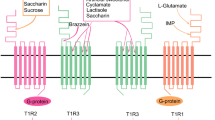Abstract.
A vast number of structurally diverse bitter compounds need to be detected by a subfamily of only ∼ 25 human bitter receptors. Failure in detecting them might be lethal, since some naturally occurring bitter compounds, such as strychnine, are very toxic. This review presents an overview about the enormous progress in the field of mammalian bitter taste research with special emphasis on humans, if data were available. It summarizes the current knowledge about the anatomical basis for bitter taste perception, intracellular signal transduction, evolution, expression and polymorphisms of hTAS2R genes, and the molecular basis for the recognition of bitter compounds.
Similar content being viewed by others
Author information
Authors and Affiliations
Corresponding author
Rights and permissions
About this article
Cite this article
Behrens, M., Meyerhof, W. Signaling in the Chemosensory Systems. Cell. Mol. Life Sci. 63, 1501–1509 (2006). https://doi.org/10.1007/s00018-006-6113-8
Published:
Issue Date:
DOI: https://doi.org/10.1007/s00018-006-6113-8




